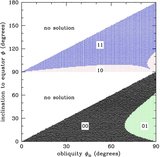Satellite Dynamics on the Laplace Surface
Abstract
The orbital dynamics of most planetary satellites is governed by the quadrupole moment from the equatorial bulge of the host planet and the tidal field from the Sun. On the Laplace surface, the long-term orbital evolution driven by the combined effects of these forces is zero, so that orbits have a fixed orientation and shape. The "classical" Laplace surface is defined for circular orbits, and coincides with the planet's equator at small planetocentric distances and with its orbital plane at large distances. A dissipative circumplanetary disk should settle to this surface, and hence satellites formed from such a disk are likely to orbit in or near the classical Laplace surface. This paper studies the properties of Laplace surfaces. Our principal results are: (1) if the planetary obliquity exceeds 68fdg875, there is a range of semimajor axes in which the classical Laplace surface is unstable; (2) at some obliquities and planetocentric distances, there is a distinct Laplace surface consisting of nested eccentric orbits, which bifurcates from the classical Laplace surface at the point where instability sets in; (3) there is also a "polar" Laplace surface perpendicular to the line of nodes of the planetary equator on the planetary orbit; (4) for circular orbits, the polar Laplace surface is stable at small planetocentric distances and unstable at large distances; (5) at the onset of instability, this polar Laplace surface bifurcates into two polar Laplace surfaces composed of nested eccentric orbits.
- Publication:
-
The Astronomical Journal
- Pub Date:
- March 2009
- DOI:
- 10.1088/0004-6256/137/3/3706
- arXiv:
- arXiv:0809.0237
- Bibcode:
- 2009AJ....137.3706T
- Keywords:
-
- planets and satellites: formation;
- planets and satellites: general;
- Astrophysics;
- Physics - Space Physics
- E-Print:
- 34 pages, 9 figures
